- Sorry, this product is unavailable.
-
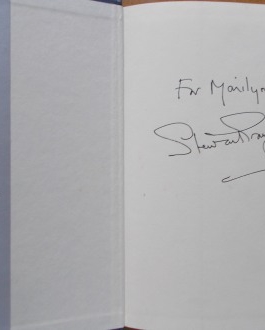
 Hollywood hunk and swash-buckler Stewart Granger tells of his leap to stardom in The Man In Grey and his overnight Hollywood success in King Solomon's Mines. He battled studio bosses, including Howard Hughes, experienced near-fatal accidents in film stunts that he always insisted on doing himself and had very close encounters with wild animals while filming in Africa and India - not to mention the temptation of being thrown together with some of the most beautiful women in the world. This iconic actor tells his story his way -with frankness, modesty and homeliness. Known for heroic sword fighting-roles such as The Prisoner of Zenda and Beau Brummell, Granger says: "I always thought I was big until I played opposite John Wayne in North to Alaska!"
Hollywood hunk and swash-buckler Stewart Granger tells of his leap to stardom in The Man In Grey and his overnight Hollywood success in King Solomon's Mines. He battled studio bosses, including Howard Hughes, experienced near-fatal accidents in film stunts that he always insisted on doing himself and had very close encounters with wild animals while filming in Africa and India - not to mention the temptation of being thrown together with some of the most beautiful women in the world. This iconic actor tells his story his way -with frankness, modesty and homeliness. Known for heroic sword fighting-roles such as The Prisoner of Zenda and Beau Brummell, Granger says: "I always thought I was big until I played opposite John Wayne in North to Alaska!" -
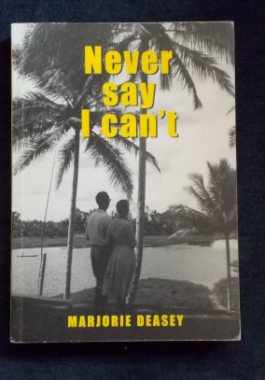

Marjorie Florence Deasey and her husband Dudley Rawson Deasey were missionaries with the Unevangelised Fields Mission/Asia Pacific Christian Mission. They lived and worked with the Gogodala people at Balimo, Papua New Guinea for over forty years. Marjorie's work included translating and teaching. When Marjorie and Dudley married in 1935, she had no idea of the enormous challenges ahead. With a limited education, she had to learn another language; deal with medical cases on her doorstep; cope with an enrollment of 600 students at her school; evacuate during the ear; survive cyclones and entertain troops. After Dudley died in 1993 – did she quietly retire? No, she decided to learn how to drive, at the age of 82. A fascinating life. Illustrated with black and white photographs.
-

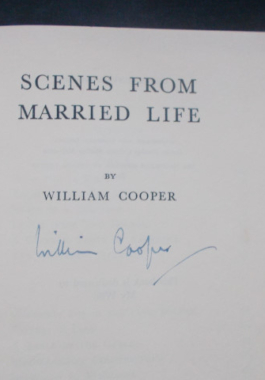 The subject here is a very rare one in novels - a happy marriage. Joe, a young man who in 1939 was sleeping with his girl but avoiding marrying her, is now in 1949 (and not so young) is still unmarried and his knowing friends have written him off as a permanent bachelor. Has he missed the boat? A third of the way into the book he triumphantly catches it, with a lovely school teacher called Elspeth. His most knowing friend, a lady psychologist says: 'It's easier to get married, than to be married.' Joe is now a temporary civil servant and a novelist, in the London of men's clubs, government offices and suburban houses but his career problem - like his non-siderish temperament - persists. Will he manage to keep his job and get his next small masterpiece published? A story written with comic incidents and serious purpose. https://rsliterature.org/fellow/william-cooper/
The subject here is a very rare one in novels - a happy marriage. Joe, a young man who in 1939 was sleeping with his girl but avoiding marrying her, is now in 1949 (and not so young) is still unmarried and his knowing friends have written him off as a permanent bachelor. Has he missed the boat? A third of the way into the book he triumphantly catches it, with a lovely school teacher called Elspeth. His most knowing friend, a lady psychologist says: 'It's easier to get married, than to be married.' Joe is now a temporary civil servant and a novelist, in the London of men's clubs, government offices and suburban houses but his career problem - like his non-siderish temperament - persists. Will he manage to keep his job and get his next small masterpiece published? A story written with comic incidents and serious purpose. https://rsliterature.org/fellow/william-cooper/ -

 Book IV of The Great South Land Saga. The beautiful valley was lonely and remote and lovely Tilly Martin longed to leave it. Only the presence of Everitt Oliver, his flattering words and dark good looks, eased her restless heart. And she intended to have him - on her own terms. But another woman, as wild and untamed as the land, passionately longed for him too. Before their destinies were decided, the valley would know murder, madness, and disgrace...a young girl born to ill-repute would get a new chance at life...and a proud settler would be humbled by the man he despised.
Book IV of The Great South Land Saga. The beautiful valley was lonely and remote and lovely Tilly Martin longed to leave it. Only the presence of Everitt Oliver, his flattering words and dark good looks, eased her restless heart. And she intended to have him - on her own terms. But another woman, as wild and untamed as the land, passionately longed for him too. Before their destinies were decided, the valley would know murder, madness, and disgrace...a young girl born to ill-repute would get a new chance at life...and a proud settler would be humbled by the man he despised. -

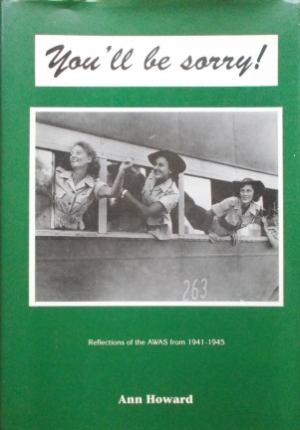
You’ll Be Sorry! Ann Howard
$45.00The part played by over 24,000 women in the Australian Army in World War II is largely unknown - until now. Here is recorded their involvement in the Cowra massacre, poisonous gas experiments, intelligence services and other ground breaking areas. Taken from first-hand revealing experiences, photos and documents. -

 Explosive and controversial, Waterfront exposes, for the first time, the real story behind the bitter 1998 war on the wharves which divided Australians and changed the nature of the workplace forever. This shocking exposè reveals who was behind it and what it means for all Australians. It all began with a 'deep throat' phone call to John Coombs, the head of Australia's most militant union, the Maritime Union of Australia. The mystery caller warned him of a clandestine plot to destroy the union's hold on the waterfront. The controversial stand-off between the Patrick Stevedoring company and the Maritime Union became a battle for the hearts and minds of the average Australian. Veteran Sydney Morning Herald journalists Trinca and Davies covered the waterfront dispute from the very beginning and take us behind the headlines to tell the real story of this real-life political thriller. Illustrated with black and white photographs. A very scarce, autographed first printing; a derogatory reference to Peter Costello caused this issue to be recalled and pulped.
Explosive and controversial, Waterfront exposes, for the first time, the real story behind the bitter 1998 war on the wharves which divided Australians and changed the nature of the workplace forever. This shocking exposè reveals who was behind it and what it means for all Australians. It all began with a 'deep throat' phone call to John Coombs, the head of Australia's most militant union, the Maritime Union of Australia. The mystery caller warned him of a clandestine plot to destroy the union's hold on the waterfront. The controversial stand-off between the Patrick Stevedoring company and the Maritime Union became a battle for the hearts and minds of the average Australian. Veteran Sydney Morning Herald journalists Trinca and Davies covered the waterfront dispute from the very beginning and take us behind the headlines to tell the real story of this real-life political thriller. Illustrated with black and white photographs. A very scarce, autographed first printing; a derogatory reference to Peter Costello caused this issue to be recalled and pulped. -
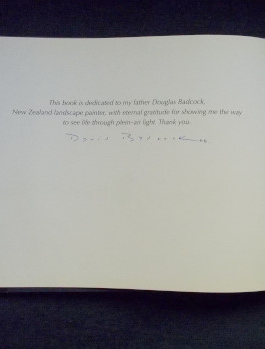

David Badcock: Plein-air Painter
$120.00The son of New Zealand artist Douglas Badcock, David came to Australia in 1977 with the dream of establishing himself as an Australian landscape painter. His journey began as a commercial artist, learning a skill to rely upon between his early exploration of the the Australian landscape and light. From one such adventure his Flinder's Ranges collection drew the attention to The Elder Fine Art Gallery in Adelaide who exhibited his location paintings for the first time in 1981. By the 1980s his dream of being an Australian landscape painter was completed and he was featured in a televised documentary series Artists of the Far North. This book of his paintings charts his remarkable journey. -

 Red In The Centre I. For the best part of a year, Monte Dwyer travelled through the country sourcing stories for broadcast on Charles Wooley's radio program Across Australia. In doing so he has captured the essence of knockabout Australia, from the naked and the light to the serious and the thoughtful. Monte is a people person and his adventures reflect the easy way in which he observes and converses with a kaleidoscope of characters. and in between, woven in some of his recollections and perceptions to make a patchwork quilt about Australia and its people. Illustrated with colour photographs.
Red In The Centre I. For the best part of a year, Monte Dwyer travelled through the country sourcing stories for broadcast on Charles Wooley's radio program Across Australia. In doing so he has captured the essence of knockabout Australia, from the naked and the light to the serious and the thoughtful. Monte is a people person and his adventures reflect the easy way in which he observes and converses with a kaleidoscope of characters. and in between, woven in some of his recollections and perceptions to make a patchwork quilt about Australia and its people. Illustrated with colour photographs. -

 "If people turn to look at you in the street, you are not well dressed, but either too stiff, too tight, or too fashionable." So said Beau Brummell, the first metrosexual, 200 years before the word was even invented. His name has become synonymous with wit, profligacy, fine tailoring, and fashion. A style pundit, Brummell was responsible for changing forever the way men dress - inventing, in effect, the suit. He cut a dramatic swath through British society, from his early years as a favorite of the Prince of Wales and an arbiter of taste in the Age of Elegance, to his precipitous fall into poverty, incarceration, and madness, creating the blueprint for celebrity crash and burn, falling dramatically out of favor and spending his last years in a hellish asylum. But for nearly two decades, Brummell ruled over the tastes and pursuits of the well heeled and influential - deemed more important than Napoleon and the inspiration for Byron's Don Juan. Through love letters, historical records, and poems, Ian Kelly reveals the man inside the suit, unlocking the scandalous behavior of London's high society while illuminating Brummell's enigmatic life in the colorful, tumultuous West End. A rare rendering of an era filled with excess, scandal, promiscuity, opulence, and luxury, 'Beau Brummell' is the first comprehensive view of an elegant and ultimately tragic figure whose influence continues to this day.
"If people turn to look at you in the street, you are not well dressed, but either too stiff, too tight, or too fashionable." So said Beau Brummell, the first metrosexual, 200 years before the word was even invented. His name has become synonymous with wit, profligacy, fine tailoring, and fashion. A style pundit, Brummell was responsible for changing forever the way men dress - inventing, in effect, the suit. He cut a dramatic swath through British society, from his early years as a favorite of the Prince of Wales and an arbiter of taste in the Age of Elegance, to his precipitous fall into poverty, incarceration, and madness, creating the blueprint for celebrity crash and burn, falling dramatically out of favor and spending his last years in a hellish asylum. But for nearly two decades, Brummell ruled over the tastes and pursuits of the well heeled and influential - deemed more important than Napoleon and the inspiration for Byron's Don Juan. Through love letters, historical records, and poems, Ian Kelly reveals the man inside the suit, unlocking the scandalous behavior of London's high society while illuminating Brummell's enigmatic life in the colorful, tumultuous West End. A rare rendering of an era filled with excess, scandal, promiscuity, opulence, and luxury, 'Beau Brummell' is the first comprehensive view of an elegant and ultimately tragic figure whose influence continues to this day. -

 Red Morgan's story begins in the great depression of the thirties to the forties, when Morgan and his sisters had to line up at the cake shop for stale cakes and then scavenge through the market garbage tips for enough food to survive on. It takes the reader through his service in the Royal Navy Cadets at the age of twelve then into the Welsh Home Guard at the age of fourteen. England was under threat of being invaded by the Germans and his home town of Swansea was being bombed every night. At fifteen he tried to join the British Merchant Navy but was told he was too young. He then joined the Norwegian Maritime Service which requested a letter and signature from his father and proof of age. He wrote a note, forged his father's signature and was on a Norwegian tanker the very next day. The war was raging now, and ships were being sunk faster than they could be built and at fifteen, Morgan was right in the middle of it all. Life at sea was hell and there are tears, laughter and one hell of a lot of loving going on during the war years as he served on petrol tankers, the most dangerous ships afloat. The story moves from ports in America, Iran, Iraq, Durban, Cape Town, India, Lorenco Marques, Italy, Alexandria and many more around the world - and many nights spent in the lockups in some of these ports. This book is a true story, written in a manner which makes the readers feel that they are in the book with the author and in his exploits around the world, written as it happened with no punches pulled, warts and all. Illustrated with black and white photographs.
Red Morgan's story begins in the great depression of the thirties to the forties, when Morgan and his sisters had to line up at the cake shop for stale cakes and then scavenge through the market garbage tips for enough food to survive on. It takes the reader through his service in the Royal Navy Cadets at the age of twelve then into the Welsh Home Guard at the age of fourteen. England was under threat of being invaded by the Germans and his home town of Swansea was being bombed every night. At fifteen he tried to join the British Merchant Navy but was told he was too young. He then joined the Norwegian Maritime Service which requested a letter and signature from his father and proof of age. He wrote a note, forged his father's signature and was on a Norwegian tanker the very next day. The war was raging now, and ships were being sunk faster than they could be built and at fifteen, Morgan was right in the middle of it all. Life at sea was hell and there are tears, laughter and one hell of a lot of loving going on during the war years as he served on petrol tankers, the most dangerous ships afloat. The story moves from ports in America, Iran, Iraq, Durban, Cape Town, India, Lorenco Marques, Italy, Alexandria and many more around the world - and many nights spent in the lockups in some of these ports. This book is a true story, written in a manner which makes the readers feel that they are in the book with the author and in his exploits around the world, written as it happened with no punches pulled, warts and all. Illustrated with black and white photographs. -


"Shane O'Donnell" was born to almost total deafness, yet he grew up to play an important part in the development of the Ord River Dam area and in conserving the natural life of that fascinating environment. The "O'Donnell" family are real. Their names were changed for the publication of this book. This is a case history of how to do the best for profoundly deaf children but more, it is a story of a fight against the odds - and winning.
-
 Edward Francis "Eddie" Charlton, AM (31 October 1929 – 8 November 2004) was an Australian professional snooker and English billiards player. He won the Australian Professional Championship numerous times, was the Pot Black Champion three times and winner of the Kronenbrau 1308 Classic and the Limosin International. He will be remembered fondly by Australians as 'Steady Eddie' and his appearances on the BBC-TV programme Pot Black.
Edward Francis "Eddie" Charlton, AM (31 October 1929 – 8 November 2004) was an Australian professional snooker and English billiards player. He won the Australian Professional Championship numerous times, was the Pot Black Champion three times and winner of the Kronenbrau 1308 Classic and the Limosin International. He will be remembered fondly by Australians as 'Steady Eddie' and his appearances on the BBC-TV programme Pot Black. -
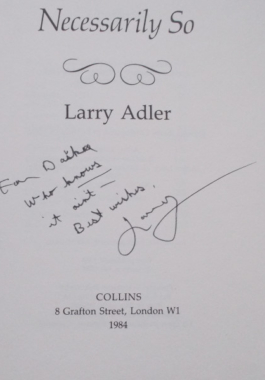 Larry Adler raised the mouth-organ from children's toy and music-hall turn to big time film and show business. He appeared alongside Eddie Cantor, Fred Astaire, George Gershwin; he played at special performances for President Roosevelt, the King of Sweden and the Prince of Wales. He toured with Jack Benny and Ingrid Bergman during the war. Then came McCarthyism and the destruction of his career. He moved to England and continued into journalism, and was nominated for an Oscar for his film score of Genevieve. Billie Holliday once remarked of his talent: "Man, you don't play that f***ing thing, you SING it!" Autographed by Larry Adler.
Larry Adler raised the mouth-organ from children's toy and music-hall turn to big time film and show business. He appeared alongside Eddie Cantor, Fred Astaire, George Gershwin; he played at special performances for President Roosevelt, the King of Sweden and the Prince of Wales. He toured with Jack Benny and Ingrid Bergman during the war. Then came McCarthyism and the destruction of his career. He moved to England and continued into journalism, and was nominated for an Oscar for his film score of Genevieve. Billie Holliday once remarked of his talent: "Man, you don't play that f***ing thing, you SING it!" Autographed by Larry Adler. -

 The world of Ben Bartholomew...a world of standover gangs and armed terrorists, a world in which a P.I. For hire must carry a gun if he wants to live beyond lunchtime. It is a world of religious fanatics, petty tyrants, spies and nightmares, which explodes with intrigue and danger when a corpse disappears from a sealed tomb. The ultimate locked-room mystery.
The world of Ben Bartholomew...a world of standover gangs and armed terrorists, a world in which a P.I. For hire must carry a gun if he wants to live beyond lunchtime. It is a world of religious fanatics, petty tyrants, spies and nightmares, which explodes with intrigue and danger when a corpse disappears from a sealed tomb. The ultimate locked-room mystery. -


Cry Crucify: Verdun Walsh
$105.00This is the story of an ordinary soldier, his experiences and those of his mates during the Malayan campaign and subsequent life as a P.O.W. in Changi, Singapore and Japan. At the time of publication (1991) it was the first and only book to tell the story of G Force and their experiences in Changi, Osaka, Takefu and Akenobi. It was typed on the reverse side of Naval Message S1320B forms on an hour-to-hour basis from January 1, 1942 - February 16, 1942. A carbon copy, typed on the same paper, was buried in a cylinder with a detailed account of the murders of Cpl. Breavington, Pte Gale and two British soldiers which brought to an end the Selerang Barrack's Changi Incident - where all P.O.Ws were herded into a square until they signed a 'Non-Escape Form'. The cylinder and its contents were retrieved after the war. The fate of the original is unknown. The story of G Force, from Changi to Japan, back to Manila and repatriation via H.M.S. Formidable - a British aircraft carrier - is supported by diaries kept by two members of G Force. Cry Crucify has been written to maintain fact from fiction and to give a balanced account of the war in Malaya and Japan, interspersed with accounts of the lighter side of P.O.W. life, together with the compassion, faith, hope and comradeship in the life of the prisoners. -

 A charming Australian story of two little rock sprites who fall into the hands of Octo the Octopus and escape, only to be captured by Pegler the Pirate, a seagull with a lame leg, who sails a ship with the black sails, with a ban of queer little animals of the bush with gipsy blood in them, who were wandering on the sea because they were tired, of the land. Peglar imprisons them in his sea castle. Can Marl the fairy rescue them? Told and illustrated by Pixie O'Harris.
A charming Australian story of two little rock sprites who fall into the hands of Octo the Octopus and escape, only to be captured by Pegler the Pirate, a seagull with a lame leg, who sails a ship with the black sails, with a ban of queer little animals of the bush with gipsy blood in them, who were wandering on the sea because they were tired, of the land. Peglar imprisons them in his sea castle. Can Marl the fairy rescue them? Told and illustrated by Pixie O'Harris. -
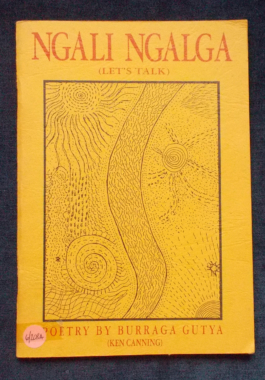
 The author of these beautiful indigenous poems is also known as Ken Canning. Powerful titles, including: Fair Skin - Black Soul; Man Of Peace; Mind Installation; Spiritless Man; Temporary Town and more. Burraga Gutya (Ken Canning) is a Murri activist, writer and poet, whose people are from the Kunja Clan of the Bidjara Nation in south west Queensland, Australia. Canning now lives and teaches in Sydney. Ken works with the Rainbow Lodge program where he supports Aboriginal men leaving custody. He first started writing poetry in Boggo Road Gaol, Brisbane in the early 1970s. Writing led him to tertiary studies at the University of Technology, Sydney, where he completed his BA in Communications in 1987.
The author of these beautiful indigenous poems is also known as Ken Canning. Powerful titles, including: Fair Skin - Black Soul; Man Of Peace; Mind Installation; Spiritless Man; Temporary Town and more. Burraga Gutya (Ken Canning) is a Murri activist, writer and poet, whose people are from the Kunja Clan of the Bidjara Nation in south west Queensland, Australia. Canning now lives and teaches in Sydney. Ken works with the Rainbow Lodge program where he supports Aboriginal men leaving custody. He first started writing poetry in Boggo Road Gaol, Brisbane in the early 1970s. Writing led him to tertiary studies at the University of Technology, Sydney, where he completed his BA in Communications in 1987. -

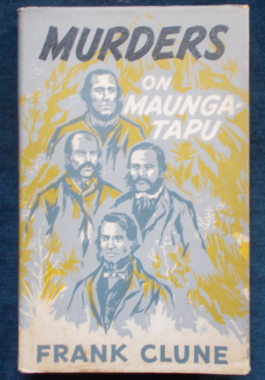 Armed robbery, murder, lies, treachery, 'confession' and legal tangle that ended in a sensational trial, followed by three executions - all the ingredients of a callous crime committed on the New Zealand goldfields in 1866. A gang of brutal Londoners - Richard Burgess, Tom Noon (Noonan), Joseph Sullivan and Phil Levy waylaid five gold-laden prospectors on a lonely track on Maungatapu ('Sacred Mountain'), killed them and hid the bodies before going on a spree. The prospectors were missed, and suspicion fell on the four. Hoping for a free pardon, Sullivan 'dobbed' on his mates and Burgess wrote a confession but implicated Sullivan. Clune traces the lives of the four and shows the influences played such an important role in shaping their twisted lives - the overcrowded Thames-side slums created by the Industrial Revolution, the laws that punished rather than reformed, the rotting prison hulks, the transportation system and the mental cruelty in the prisons of the day.
Armed robbery, murder, lies, treachery, 'confession' and legal tangle that ended in a sensational trial, followed by three executions - all the ingredients of a callous crime committed on the New Zealand goldfields in 1866. A gang of brutal Londoners - Richard Burgess, Tom Noon (Noonan), Joseph Sullivan and Phil Levy waylaid five gold-laden prospectors on a lonely track on Maungatapu ('Sacred Mountain'), killed them and hid the bodies before going on a spree. The prospectors were missed, and suspicion fell on the four. Hoping for a free pardon, Sullivan 'dobbed' on his mates and Burgess wrote a confession but implicated Sullivan. Clune traces the lives of the four and shows the influences played such an important role in shaping their twisted lives - the overcrowded Thames-side slums created by the Industrial Revolution, the laws that punished rather than reformed, the rotting prison hulks, the transportation system and the mental cruelty in the prisons of the day.


